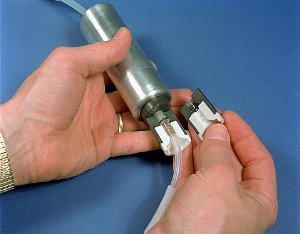The chemical element thulium is classed as a lanthanide and rare earth metal. It was discovered in 1879 by Per Teodor Cleve.

Data Zone
| Classification: | Thulium is a lanthanide and rare earth metal |
| Color: | silvery-gray |
| Atomic weight: | 168.9342 |
| State: | solid |
| Melting point: | 1550 oC, 1823 K |
| Boiling point: | 1950 oC, 2223 K |
| Electrons: | 69 |
| Protons: | 69 |
| Neutrons in most abundant isotope: | 100 |
| Electron shells: | 2,8,18,31,8,2 |
| Electron configuration: | [Xe] 4f13 6s2 |
| Density @ 20oC: | 9.33 g/cm3 |
Reactions, Compounds, Radii, Conductivities
| Atomic volume: | 18.1 cm3/mol |
| Structure: | hexagonal close packed |
| Specific heat capacity | 0.16 J g-1 K-1 |
| Heat of fusion | 16.840 kJ mol-1 |
| Heat of atomization | 232 kJ mol-1 |
| Heat of vaporization | 191.0 kJ mol-1 |
| 1st ionization energy | 596.7 kJ mol-1 |
| 2nd ionization energy | 1163 kJ mol-1 |
| 3rd ionization energy | 2285 kJ mol-1 |
| Electron affinity | 99 kJ mol-1 |
| Minimum oxidation number | 0 |
| Min. common oxidation no. | 0 |
| Maximum oxidation number | 3 |
| Max. common oxidation no. | 3 |
| Electronegativity (Pauling Scale) | 1.25 |
| Polarizability volume | 28.8 Å3 |
| Reaction with air | mild, ⇒ Tm2O3 |
| Reaction with 15 M HNO3 | mild, ⇒ Tm(NO3)3 |
| Reaction with 6 M HCl | mild, ⇒ H2, TmCl3 |
| Reaction with 6 M NaOH | – |
| Oxide(s) | Tm2O3 (thulia) |
| Hydride(s) | TmH2, TmH3 |
| Chloride(s) | TmCl2, TmCl3 |
| Atomic radius | 175 pm |
| Ionic radius (1+ ion) | – |
| Ionic radius (2+ ion) | 117 pm |
| Ionic radius (3+ ion) | 102 pm |
| Ionic radius (1- ion) | – |
| Ionic radius (2- ion) | – |
| Ionic radius (3- ion) | – |
| Thermal conductivity | 16.9 W m-1 K-1 |
| Electrical conductivity | 1.3 x 106 S m-1 |
| Freezing/Melting point: | 1550 oC, 1823 K |
Discovery of Thulium
Per Teodor Cleve discovered two new materials, one green and one brown, while working with erbia (erbium oxide) in 1879, in Uppsala, Sweden. These turned out to be oxides of two new elements: thulium and holmium. (1), (2)
The green substance he named thulia, which he later found to be thulium oxide and the brown substance he named holmia, which he later found to be holmium oxide.
Cleve’s discovery was similar to those of Swedish chemist Carl Gustaf Mosander in 1843. Mosander discovered erbium and terbium in yttria, which is mainly comprised of yttrium oxide.
Charles James in New Hampshire, prepared the first pure thulium in 1911 by repeated bromate fractional crystallizations, which became known as the ‘James Method.’ (3),(4)
The element name comes from ‘Thule’, an ancient name for Scandinavia.


Euro banknotes use rare earth chemistry to defeat counterfeiters. Shining UV light on a euro results in blue fluorescence from thulium Tm3+, red from europium Eu3+, and green from terbium Tb3+.
Appearance and Characteristics
Harmful effects:
Thulium is considered to be non-toxic.
Characteristics:
Thulium is a bright, soft, malleable, silvery-gray metal.
It is a rare earth metal and is one of the least abundant.
The metal tarnishes slowly in dry air to form the oxide and reacts with water to form the hydroxide and hydrogen gas.
Tm3+ ions emit a strong blue luminescence when excited.
When present in compounds, thulium exists usually in the trivalent state, Tm3+. It forms compounds – mostly green in color – with oxygen and the halogens.
Uses of Thulium
Radioactive isotope 170Tm is produced by bombarding thulium in a nuclear reactor. It has a half-life of 128 days and is used as a portable source of x-rays.
Thulium is used to dope yttrium aluminum garnets (YAG) used in lasers.
Thulium is also used in alloys with other rare earth metals.
Thulium is used in euro banknotes for its blue fluorescence under UV light to defeat counterfeiters.
Abundance and Isotopes
Abundance earth’s crust: 0.5 parts per million by weight, 50 parts per billion by moles
Abundance solar system: 200 parts per trillion by weight, 1 part per trillion by moles
Cost, pure: $700 per 10g
Cost, bulk: $ per 100g
Source: Thulium is not found free in nature but is found in a number of minerals: mainly monazite, gadolinite, xenotime and euxenite. Commercially, it is isolated by ion exchange and solvent extraction. The metal can be isolated by reduction of the anhydrous fluoride with calcium metal, or by the reduction of the oxide with lanthanum metal.
Isotopes: Thulium has 32 isotopes whose half-lives are known, with mass numbers 146 to 177. Naturally occurring thulium consists of its one stable isotope, 169Tm.

References
- Mary Elvira Weeks, The Discovery of the Elements XVI., Journal of Chemical Education., October 1932, p1761,1762.
- Robert E. Krebs, The history and use of our earth’s chemical elements: a reference guide., JGreenwood Publishing Group, 2006, p300.
- James Roy Newman, The International encyclopedia of science., Volume 4, Nelson, 1965, p1186.
- University of New Hampshire Alumni Association, The Life and Work of Charles James.
Cite this Page
For online linking, please copy and paste one of the following:
<a href="https://www.chemicool.com/elements/thulium.html">Thulium</a>
or
<a href="https://www.chemicool.com/elements/thulium.html">Thulium Element Facts</a>
To cite this page in an academic document, please use the following MLA compliant citation:
"Thulium." Chemicool Periodic Table. Chemicool.com. 24 Jul. 2015. Web. <https://www.chemicool.com/elements/thulium.html>.

this site is good because when i need it for school work like since im only in the 7th grade.
I know, i’m in eighth grade and my class is doing work on the periodic table and my element was thulium
yes helpful